人教版英语九年级全册 Unit 3 Could you please tell me where the restrooms are 讲义(知识梳理和练习)
文档属性
| 名称 | 人教版英语九年级全册 Unit 3 Could you please tell me where the restrooms are 讲义(知识梳理和练习) | 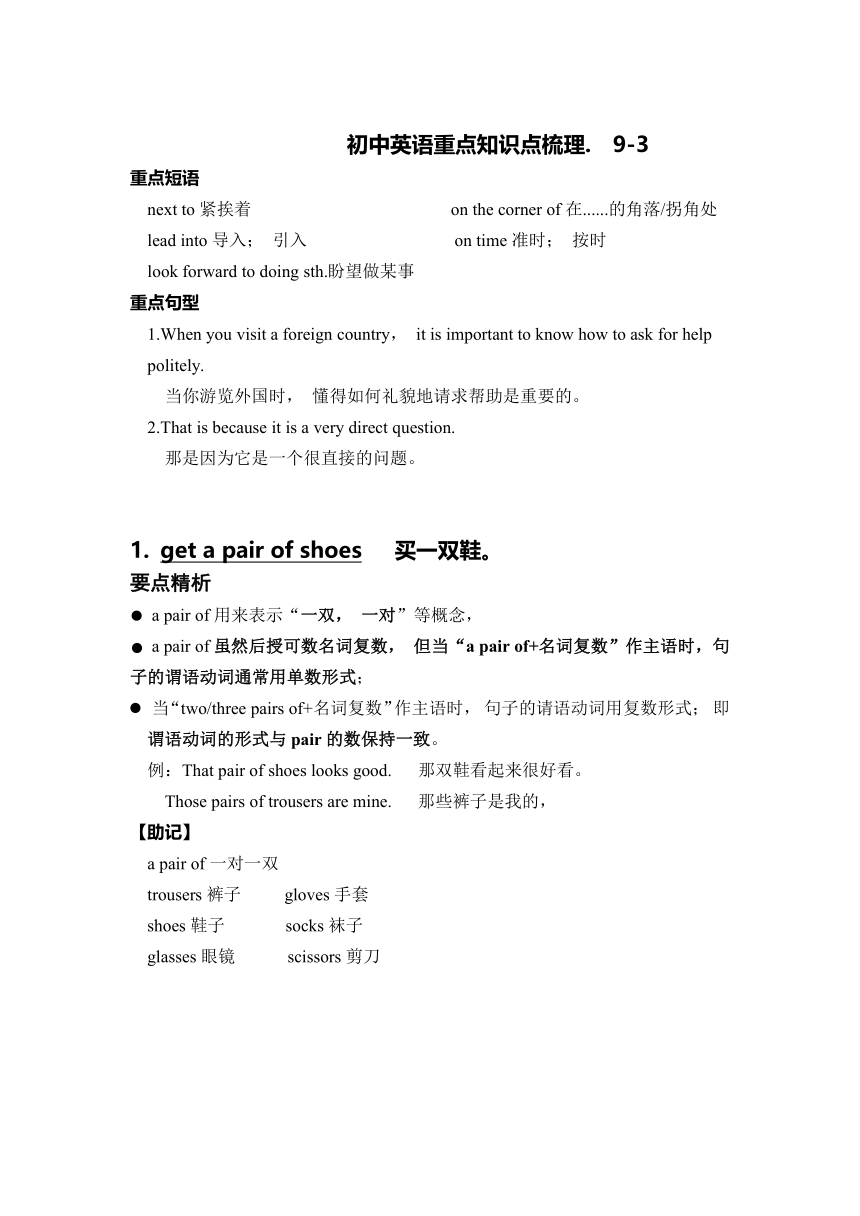 | |
| 格式 | docx | ||
| 文件大小 | 84.6KB | ||
| 资源类型 | 教案 | ||
| 版本资源 | 人教新目标(Go for it)版 | ||
| 科目 | 英语 | ||
| 更新时间 | 2021-08-24 15:46:51 | ||
图片预览

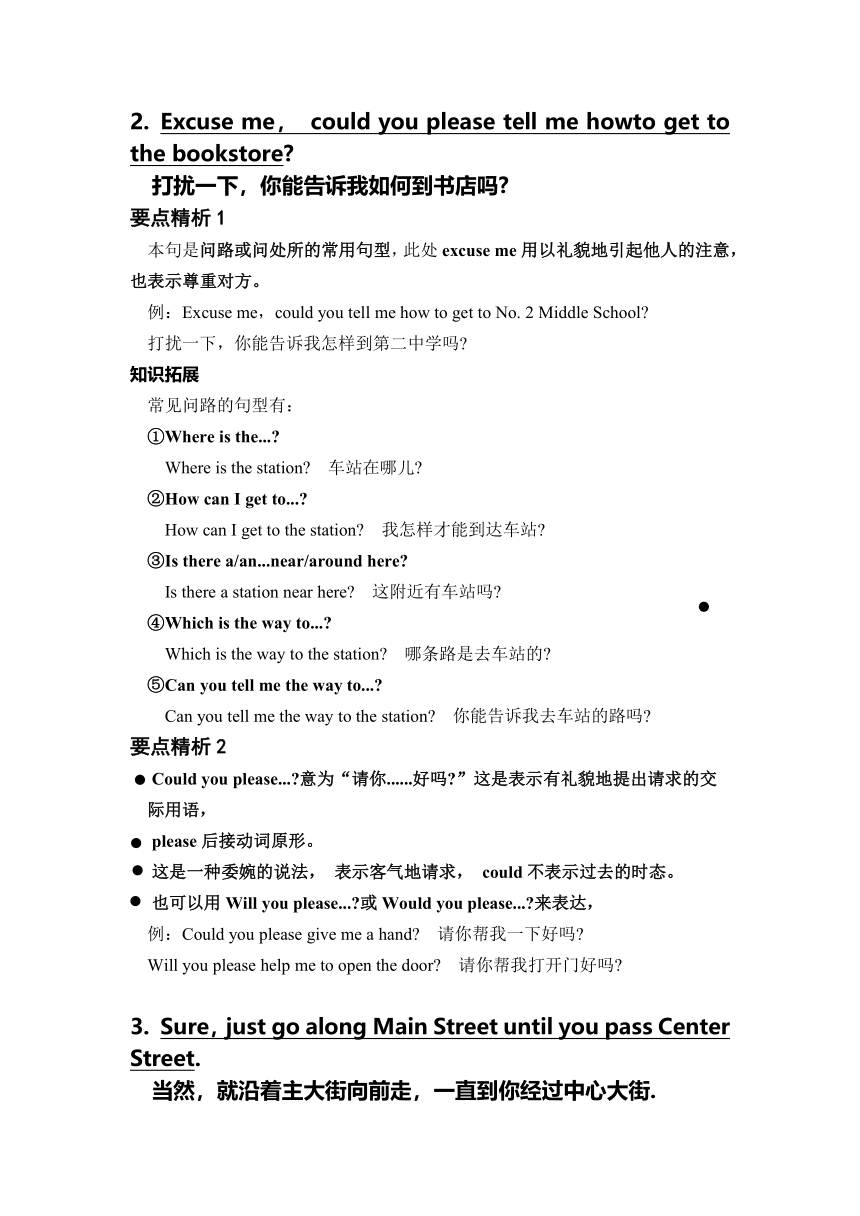
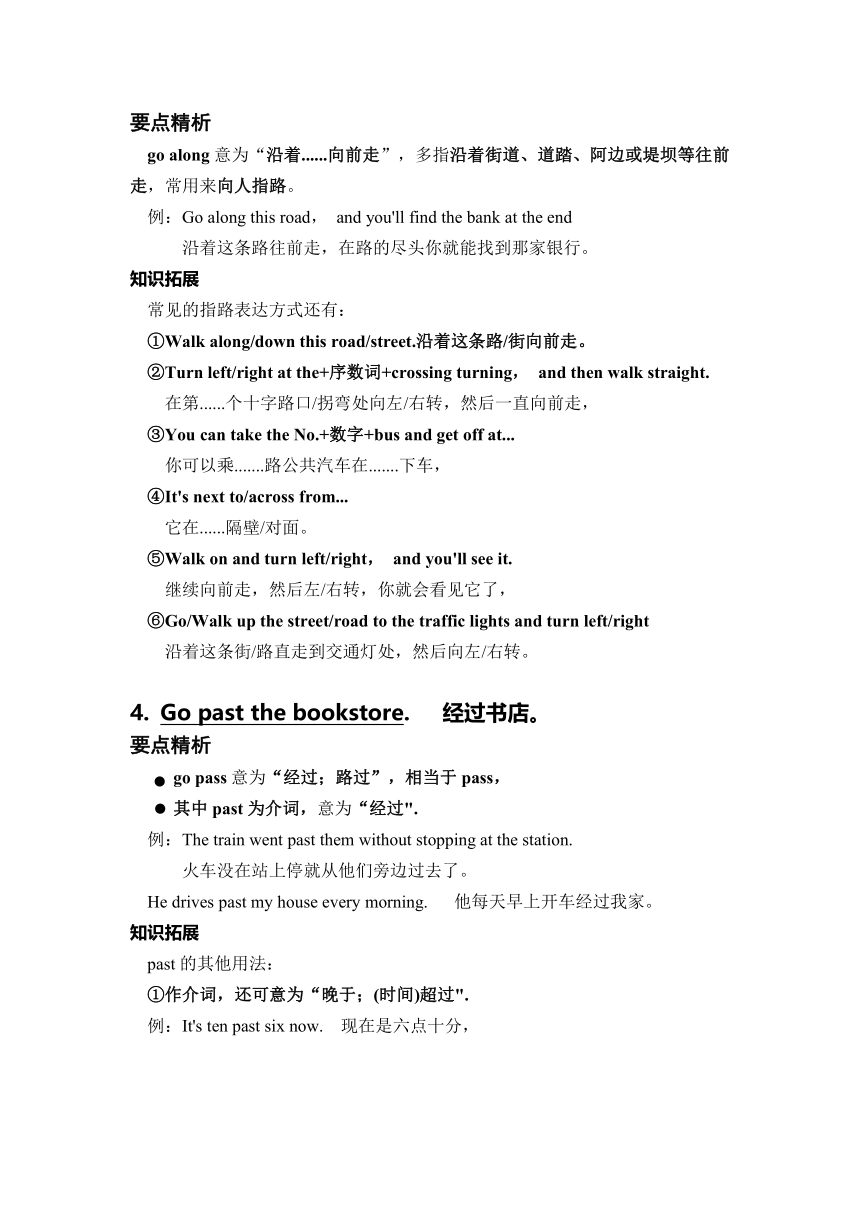
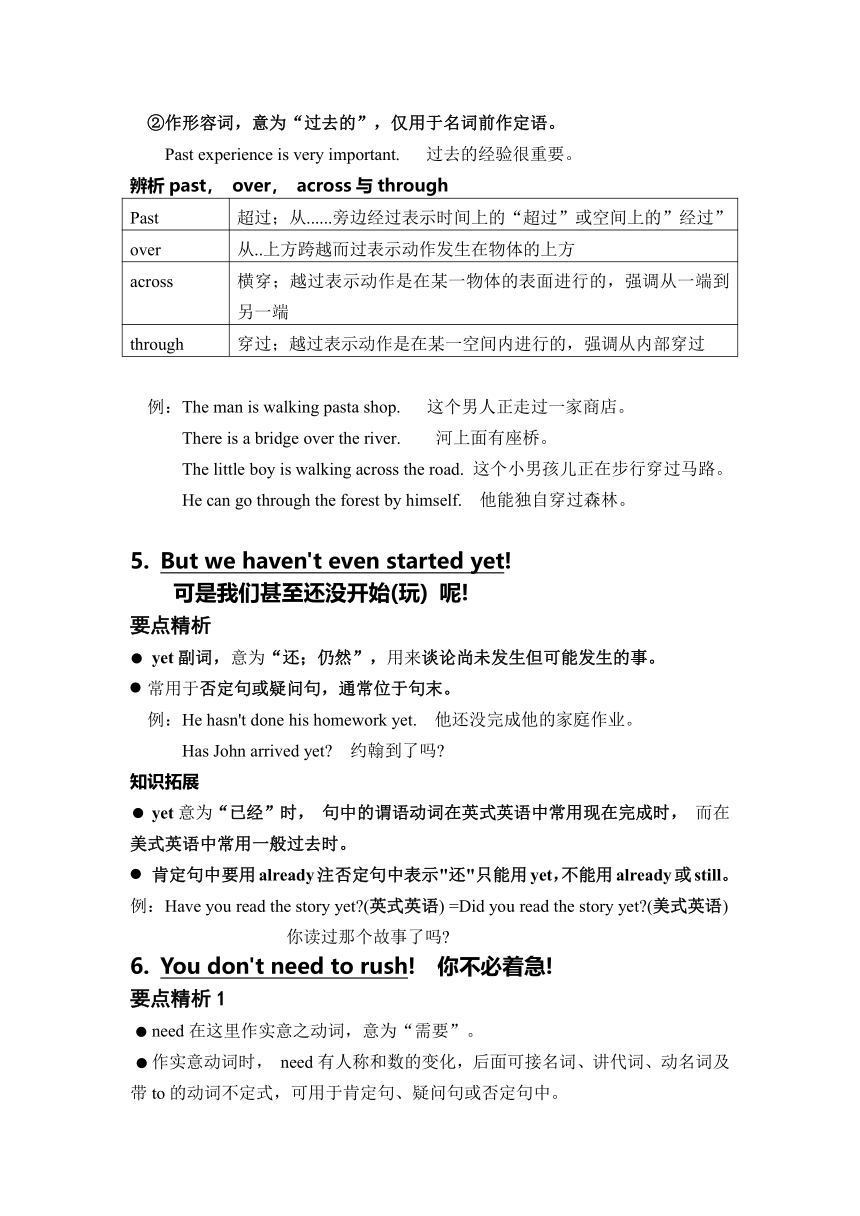
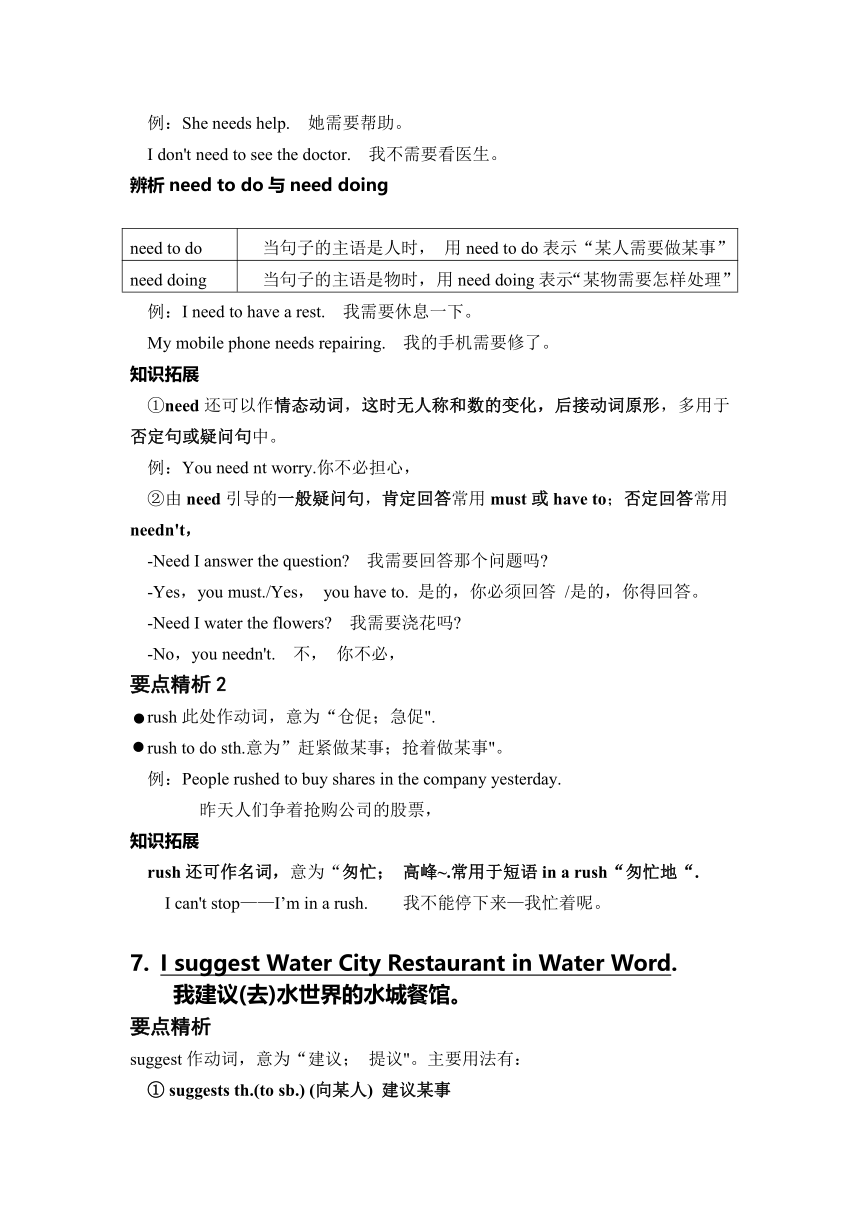
文档简介
初中英语重点知识点梳理.
9-3
重点短语
next
to紧挨着
on
the
corner
of在......的角落/拐角处
lead
into导入;
引入
on
time准时;
按时
look
forward
to
doing
sth.盼望做某事
重点句型
1.When
you
visit
a
foreign
country,
it
is
important
to
know
how
to
ask
for
help
politely.
当你游览外国时,
懂得如何礼貌地请求帮助是重要的。
2.That
is
because
it
is
a
very
direct
question.
那是因为它是一个很直接的问题。
get
a
pair
of
shoes
买一双鞋。
要点精析
a
pair
of用来表示“一双,
一对”等概念,
a
pair
of虽然后授可数名词复数,
但当“a
pair
of+名词复数”作主语时,句子的谓语动词通常用单数形式;
当“two/three
pairs
of+名词复数”作主语时,
句子的请语动词用复数形式;
即
谓语动词的形式与pair的数保持一致。
例:That
pair
of
shoes
looks
good.
那双鞋看起来很好看。
Those
pairs
of
trousers
are
mine.
那些裤子是我的,
【助记】
a
pair
of一对一双
trousers裤子
gloves手套
shoes鞋子
socks袜子
glasses眼镜
scissors剪刀
Excuse
me,
could
you
please
tell
me
howto
get
to
the
bookstore?
打扰一下,你能告诉我如何到书店吗?
要点精析1
本句是问路或问处所的常用句型,此处excuse
me用以礼貌地引起他人的注意,也表示尊重对方。
例:Excuse
me,could
you
tell
me
how
to
get
to
No.
2
Middle
School?
打扰一下,你能告诉我怎样到第二中学吗?
知识拓展
常见问路的句型有:
①Where
is
the...?
Where
is
the
station?
车站在哪儿?
②How
can
I
get
to...?
How
can
I
get
to
the
station?
我怎样才能到达车站?
③Is
there
a/an...near/around
here?
Is
there
a
station
near
here?
这附近有车站吗?
④Which
is
the
way
to...?
Which
is
the
way
to
the
station?
哪条路是去车站的?
⑤Can
you
tell
me
the
way
to...?
Can
you
tell
me
the
way
to
the
station?
你能告诉我去车站的路吗?
要点精析2
Could
you
please...?意为“请你......好吗?”这是表示有礼貌地提出请求的交
际用语,
please后接动词原形。
这是一种委婉的说法,
表示客气地请求,
could不表示过去的时态。
也可以用Will
you
please...?或Would
you
please...?来表达,
例:Could
you
please
give
me
a
hand?
请你帮我一下好吗?
Will
you
please
help
me
to
open
the
door?
请你帮我打开门好吗?
Sure,just
go
along
Main
Street
until
you
pass
Center
Street.
当然,就沿着主大街向前走,一直到你经过中心大街.
要点精析
go
along意为“沿着......向前走”,多指沿着街道、道踏、阿边或堤坝等往前走,常用来向人指路。
例:Go
along
this
road,
and
you'll
find
the
bank
at
the
end
沿着这条路往前走,在路的尽头你就能找到那家银行。
知识拓展
常见的指路表达方式还有:
①Walk
along/down
this
road/street.沿着这条路/街向前走。
②Turn
left/right
at
the+序数词+crossing
turning,
and
then
walk
straight.
在第......个十字路口/拐弯处向左/右转,然后一直向前走,
③You
can
take
the
No.+数字+bus
and
get
off
at...
你可以乘.......路公共汽车在.......下车,
④It's
next
to/across
from...
它在......隔壁/对面。
⑤Walk
on
and
turn
left/right,
and
you'll
see
it.
继续向前走,然后左/右转,你就会看见它了,
⑥Go/Walk
up
the
street/road
to
the
traffic
lights
and
turn
left/right
沿着这条街/路直走到交通灯处,然后向左/右转。
Go
past
the
bookstore.
经过书店。
要点精析
go
pass意为“经过;路过”,相当于pass,
其中past为介词,意为“经过".
例:The
train
went
past
them
without
stopping
at
the
station.
火车没在站上停就从他们旁边过去了。
He
drives
past
my
house
every
morning.
他每天早上开车经过我家。
知识拓展
past的其他用法:
①作介词,还可意为“晚于;(时间)超过".
例:It's
ten
past
six
now.
现在是六点十分,
②作形容词,意为“过去的”,仅用于名词前作定语。
Past
experience
is
very
important.
过去的经验很重要。
辨析past,
over,
across与through
Past
超过;从......旁边经过表示时间上的“超过”或空间上的”经过”
over
从..上方跨越而过表示动作发生在物体的上方
across
横穿;越过表示动作是在某一物体的表面进行的,强调从一端到另一端
through
穿过;越过表示动作是在某一空间内进行的,强调从内部穿过
例:The
man
is
walking
pasta
shop.
这个男人正走过一家商店。
There
is
a
bridge
over
the
river.
河上面有座桥。
The
little
boy
is
walking
across
the
road.
这个小男孩儿正在步行穿过马路。
He
can
go
through
the
forest
by
himself.
他能独自穿过森林。
But
we
haven't
even
started
yet!
可是我们甚至还没开始(玩)
呢!
要点精析
yet副词,意为“还;仍然”,用来谈论尚未发生但可能发生的事。
常用于否定句或疑问句,通常位于句末。
例:He
hasn't
done
his
homework
yet.
他还没完成他的家庭作业。
Has
John
arrived
yet?
约翰到了吗?
知识拓展
yet意为“已经”时,
句中的谓语动词在英式英语中常用现在完成时,
而在美式英语中常用一般过去时。
肯定句中要用already注否定句中表示"还"只能用yet,不能用already或still。
例:Have
you
read
the
story
yet?(英式英语)
=Did
you
read
the
story
yet?(美式英语)
你读过那个故事了吗?
You
don't
need
to
rush!
你不必着急!
要点精析1
need在这里作实意之动词,意为“需要”。
作实意动词时,
need有人称和数的变化,后面可接名词、讲代词、动名词及带to的动词不定式,可用于肯定句、疑问句或否定句中。
例:She
needs
help.
她需要帮助。
I
don't
need
to
see
the
doctor.
我不需要看医生。
辨析need
to
do与need
doing
need
to
do
当句子的主语是人时,
用need
to
do表示“某人需要做某事”
need
doing
当句子的主语是物时,
用need
doing表示“某物需要怎样处理”
例:I
need
to
have
a
rest.
我需要休息一下。
My
mobile
phone
needs
repairing.
我的手机需要修了。
知识拓展
①need还可以作情态动词,这时无人称和数的变化,后接动词原形,多用于否定句或疑问句中。
例:You
need
nt
worry.你不必担心,
②由need引导的一般疑问句,肯定回答常用must或have
to;否定回答常用needn't,
-Need
I
answer
the
question?
我需要回答那个问题吗?
-Yes,you
must./Yes,
you
have
to.
是的,你必须回答
/是的,你得回答。
-Need
I
water
the
flowers?
我需要浇花吗?
-No,you
needn't.
不,
你不必,
要点精析2
rush此处作动词,意为“仓促;急促".
rush
to
do
sth.意为”赶紧做某事;抢着做某事"。
例:People
rushed
to
buy
shares
in
the
company
yesterday.
昨天人们争着抢购公司的股票,
知识拓展
rush还可作名词,意为“匆忙;
高峰~.常用于短语in
a
rush“匆忙地“.
I
can't
stop——I’m
in
a
rush.
我不能停下来—我忙着呢。
I
suggest
Water
City
Restaurant
in
Water
Word.
我建议(去)水世界的水城餐馆。
要点精析
suggest作动词,意为“建议;
提议"。主要用法有:
①
suggests
th.(to
sb.)
(向某人)
建议某事
例:He
suggested
a
picnic
yesterday.
昨天他提议去野餐。
②
suggest
doing
sth.建议做某事
He
suggested
going
there
on
foot.
他建议步行去那里。
③
suggest+that引导的宾语从句,章为“建议......"这时宾语从句要用虚拟语气,谓语动词用气should+)
动词原形".
He
suggests
that
we(should)
do
it
at
once.
他建议我们立刻做这件事。
知识拓展
①suggest作动词,还可以作“显示,间接表明,暗示”讲,后接名词、代词或从句作宾语,接从句时,从句不用虚拟语气。
例:Her
look
suggested
that
she
had
known
the
news
她的表情表明她已经知道了那个消息,
②suggest的名词形式是suggestion,意为“建议;
提议"。
May
I
make
a
suggestion?
我可以提个建议吗?
When
you
visit
a
foreign
country,
it
is
important
to
know
how
to
ask
for
help
politely.
当你游览外国时,懂得如何礼貌地请求帮助是重要的。
要点精析1
此句是包含when引导的时间状语从句的主从复合句,从句用于表示主句动作发生的特定时间.
例:The
days
get
longer
when
spring
comes.=When
spring
comes,
the
days
get
longer.
春天到来时,白天变长了。
知识拓展
当时间状语从句用一般现在时时,主句通常用一般将来时。
但如果主句表示的是客观真理或不可改变的现象时,主句仍然用一般现在时。
例:We
will
go
to
the
park
for
a
picnic
together
when
my
father
comes
back.
当我父亲回来时,我们就一起去公园野餐。
要点精析2
politely副词,章为“礼貌地;客气地"。
例:She
speaks
to
everyone
politely.
她对每个人说话都很有礼貌。
These
are
similar
requests
for
direction.
这些均是关于问路的类似请求。
要点精析1
request可数名词,意为“要求;请求”
当其后接表示请求的具体内容时,常与介词for搭配。
例:Mr.Smith
refused
their
request
for
a
meeting.
史密斯先生拒绝了他们会面的要求。
知识拓展
①make
a
request(for
sth.)
要求/请求(某事物)
They
decided
to
make
a
request
for
inter-national
aid.
他们决定请求国际帮助,
②request还可作及物动词,意为“要求;请求",
常用于搭配requests
th.from
sb.“向某人请求/要求某事物”,requests
b.to
do
sth.“请求/要求某人做某事".
例:They
tried
to
request
help
from
the
society.
他们试图向社会寻求帮助,
The
English
teacher
requests
us
to
hand
in
our
homework
on
time.
英语老师要求我们按时交作业,
要点精析2
direction名词,意为“方向;
方位".
在此处指(对行路方向的)
指引”,这一用法时它常用复数形式,
常与give,
ask
for等动词(短语)
及介词to搭配。
例:Let's
stop
and
ask
for
directions.
咱们停下来问问路吧。
The
expressions
they
use
might
depend
on
whom
they
are
speaking
to
or
how
well
they
know
each
other.
他们使用的表达方式可能取决于他们和谁说话或他们对彼此的熟悉程度。
要点精析1
they
use是省略了关系代词that或which的定语从句,修饰先行词the
expressions,表示“他们使用的表达方式"。
定语从句要放在它所修饰的词的后面。
例:The
people
who
called
yesterday
want
to
buy
the
house.
昨天打来电话的人想买这座房子。
要点精析2
whom
they
are
speaking
to
or
how
well
they
know
each
other是由whom和
how引导的宾语从句,作on的宾语,宾语从句用陈述语序。
例:He
didn't
tell
me
when
we
would
meet
and
where
we
would
eat.
他没有告诉我我们将何时见面及在哪里吃饭。
Sometimes
we
even
need
to
spend
time
leading
into
a
request.
有时候,
我们甚至需要花时间来导入一个请求。
要点精析
spend动词,意为“花费(金钱、时间等),主语是人,
例:I
spent
two
hours(in)
reading
the
novel.
我花了两个小时读这篇小说,
辨析spend,
pay,
take与cost
spend
常用结构:spend...(in)
doing
sth.(花费......做某事)
或spend.on
sth.(在某事/某物上花费......
pay
意为“付费",
主语是人,常用于Sb.pay(s)
/paid
some
money
for
sth.(某人为某物花费一些钱)
句型中
take
意为“花费”常用于It
takes/took
sb....todos
th(做某事花费某人......)句型中
cost
意为“花费",主语是物,
常用于Sth.cost(s)
sb.some
money(某物花费某人一些钱)句型中
例:We
spent
one
year
in)
building
the
bridge.
我们花费了一年建这座桥,
I
paid
100
dollars
for
the
bike.
我花一百美元买了这辆自行车,
It
took
me
two
hours
to
do
my
homework.
做家庭作业花了我两个小时的时间。
This
bike
cost
me
100
dollars.
这辆自行车花了我100美元。
12.thank
the
person
for
helping
you.
感谢这个人帮助你。
要点精析
thank
sb,for(doing)
sh.意为“因(做)
某事而感谢某人”,其中for为介词,
后跟名词、代词或动词-ing形式作宾语.
Thank
you
for(doing)
sth.相当于thanks
for(doing)
sth..
例:Thank
the
boy
for
his
advice.
谢谢那个男孩儿给的建议,
Thank
you
for(=Thanks
for)
teaching
us
so
well.
谢谢你把我们教得如此好
知识拓屏
thanks
to
sb./sth.表示“多亏;
因为;
由于”的意思。
例:Thanks
to
Mr.Zhang.He
made
great
progress
in
English.
多了张老师,他的英语取得了很大的进步。
Thanks
to
your
program,we
got
to
know
each
other.
因为你们的节目,我们方能相互认识。
I’d
like
to
know
about...
我想知道有关......
要点精析
would
like意为“想,想要”,
与want同义,但在语气上比want更要婉,
would
like的用法主要有:
①
would
like
sth.想要某物
例:I
d
like
some
apples.
我想要一些苹果.
②
would
like
to
do
sth.
想要做某事
He'd
like
to
go
to
the
supermarket.他想去超市。
③
would
like
sb.to
do
sth.
想要某人做某事
She'd
like
me
to
go
shopping
with
her.她想要我和她一起去购物。
知识拓展
①would
like无人称和数的变化,一般疑问句把would提到主语之前。
②Would
you
like...?问句的肯定回答多用Yes,please./Yes,I’d/We'd
like/love
to./Certainly./Yes,thank
you.等;否定回答常用No,thanks./No,thank
you.
等,
例:-Would
you
like
some
tea?
你想要喝茶吗?
-Yes,thank
you.
是的,谢谢。
-Would
you
like
to
stay
here
with
us?
你想和我们一起待在这儿吗?
-Yes,
I’d
love
to.
是的,我想。
I’m
looking
forward
to
your
reply.
我期待着你的回复。
要点精析1
look
forward
to意为“盼望;期待”,其中to是介词,其后可接名词、代词或动词-ing形式。
例:I’m
looking
forward
to
receiving
your
letter.
我盼望着收到你的来信。
要点精析2
reply既可以用作名词,也可以用作动词,意为“回答”,与answer同义,
辨析reply与answer
reply
比answer正式,既可指口头或书面作答,也可指用动作或手势作答,常用于正式场合或书面语中,指经过慎重考虑做出的答复。
answer
可指口头或书面作答,也可指用行动回答,
口语中用的多,
有时可与reply通用。
例:I
sent
in
my
application,and
the
school
replied
immediately
我把申请书交上去了,学校方面立即给了答复。
I
don't
know
what
to
reply.
我不知道该回答什么。
Who
can
answer
the
question?
谁能回答这个问题?
Please
answer
the
telephone.
请接一下电话。
知识拓展
在表示回答问题时,answer后直接跟question;
reply后要加介词to。
即学即试
一、根据汉语意思完成句子
1.你知道书店今天什么时候关门吗?
Do
you
know________
the
bookstore________today?
2.我妈妈给我买了一双新鞋。
My
mother
bought
me________
________
________
new
shoes.
3.我们没有必要急着走,时间还早,
We________
________to
rush.It
is
still
early.
4.超市在花店和书店之间。
The
supermarket
is________
the
flower
store________the
bookstore.
5.沿着主大街向前走,直到你经过中心大街。
________
________
Main
Street
until
you
pass
Center
Street.
二、单项选择
1.-When
will
he
come?
-When________,I’ll
let
you
know.
A.does
he
come
B.he
comes
C.will
he
come
D.he
will
come
2.-How
much
is
the
ticket
to
the
Central
Park?
-A
one-way
ticket________$40,and
you
can________another$
20
for
around
trip.
A.costs;pay
B.cost;spend
C.pay;spend
D.spends;pay
3.
-Hi,Bruce.Here
is
a
letter
for
you.
-Thanks.
I
wonder________.
A.who
the
letter
was
from
B.who
was
from
the
letter
C
who
was
the
letter
from
D
who
from
the
letter
was
4.
The
woman
asked
the
policeman
where________.
A.the
post
office
is
B.was
the
post
office
C.is
the
post
office
D.the
post
office
was
5.-Tom,would
you
like
to
train
our
football
team?
-________
A.Sure,I’d
like
to
B.You're
welcome
C.Its
my
pleasure
D.Not
at
all
6.
-Could
you
please
tell
me
________?
-About
twenty
minutes
ago.
A.when
did
you
see
this
kid
B.where
did
you
see
this
kid
C.when
you
saw
this
kid
D.where
you
saw
this
kid
7.-Hi,Lily!Why
don’t
you
go
swimming
with
them?
-Because
I________my
homework
yet.
A.didn't
finish
B.wont
finish
C.haven’t
finished
D.don't
finish
8.-When
shall
we
begin
our
meeting?
-Well
begin
it
when
Helen________.
A.comes
B.came
C.will
come
D.come
9.Thanks
to
the
robots,the
human
reporters
do
not
have
to
spend
a
lot
of
time________numbers
and
information.
A.processing
B.to
process
C.processed
D.process
10.-Hell
Mom.Longtime
no
see
-Hello!Mary.Are
you
busy
these
days?lam
looking
forward________your
phone.
A.to
answer
B.answering
C.to
answering
D.answer
参考答案:
l.when,
closes
2.a
pair
of
3.don't
need
4.between,
and
5.Go
along
Ⅱ
1.B由主句TH
let
you
know用一般将来时可知,
时间状语从句要用一般现在时且用陈述语序,故选B,
2.A
cost花费”,
物作主语;
spend“花费”人作主语;
pay
for“付款",
人作主语,所以选A.
3.A在主从复合句中,
宾语从句的语序要用陈述语序。短语be
from意为“来自".答语句意为“多谢。我想知道这封信是谁发来的",所以选A.
4.D宾语从句用陈述语序,B、C两项语序不对,故排除;主句用一般过去时,从句受主句限制,要用过去的某种时态,排除A,所以选D,
5.A回答Would
you
like
to
do...?问句时,
肯定回答用Yes/Sure,
I’d
like
to,
故选A.
6.C
7.C
8.A
9.A
10.C
9-3
重点短语
next
to紧挨着
on
the
corner
of在......的角落/拐角处
lead
into导入;
引入
on
time准时;
按时
look
forward
to
doing
sth.盼望做某事
重点句型
1.When
you
visit
a
foreign
country,
it
is
important
to
know
how
to
ask
for
help
politely.
当你游览外国时,
懂得如何礼貌地请求帮助是重要的。
2.That
is
because
it
is
a
very
direct
question.
那是因为它是一个很直接的问题。
get
a
pair
of
shoes
买一双鞋。
要点精析
a
pair
of用来表示“一双,
一对”等概念,
a
pair
of虽然后授可数名词复数,
但当“a
pair
of+名词复数”作主语时,句子的谓语动词通常用单数形式;
当“two/three
pairs
of+名词复数”作主语时,
句子的请语动词用复数形式;
即
谓语动词的形式与pair的数保持一致。
例:That
pair
of
shoes
looks
good.
那双鞋看起来很好看。
Those
pairs
of
trousers
are
mine.
那些裤子是我的,
【助记】
a
pair
of一对一双
trousers裤子
gloves手套
shoes鞋子
socks袜子
glasses眼镜
scissors剪刀
Excuse
me,
could
you
please
tell
me
howto
get
to
the
bookstore?
打扰一下,你能告诉我如何到书店吗?
要点精析1
本句是问路或问处所的常用句型,此处excuse
me用以礼貌地引起他人的注意,也表示尊重对方。
例:Excuse
me,could
you
tell
me
how
to
get
to
No.
2
Middle
School?
打扰一下,你能告诉我怎样到第二中学吗?
知识拓展
常见问路的句型有:
①Where
is
the...?
Where
is
the
station?
车站在哪儿?
②How
can
I
get
to...?
How
can
I
get
to
the
station?
我怎样才能到达车站?
③Is
there
a/an...near/around
here?
Is
there
a
station
near
here?
这附近有车站吗?
④Which
is
the
way
to...?
Which
is
the
way
to
the
station?
哪条路是去车站的?
⑤Can
you
tell
me
the
way
to...?
Can
you
tell
me
the
way
to
the
station?
你能告诉我去车站的路吗?
要点精析2
Could
you
please...?意为“请你......好吗?”这是表示有礼貌地提出请求的交
际用语,
please后接动词原形。
这是一种委婉的说法,
表示客气地请求,
could不表示过去的时态。
也可以用Will
you
please...?或Would
you
please...?来表达,
例:Could
you
please
give
me
a
hand?
请你帮我一下好吗?
Will
you
please
help
me
to
open
the
door?
请你帮我打开门好吗?
Sure,just
go
along
Main
Street
until
you
pass
Center
Street.
当然,就沿着主大街向前走,一直到你经过中心大街.
要点精析
go
along意为“沿着......向前走”,多指沿着街道、道踏、阿边或堤坝等往前走,常用来向人指路。
例:Go
along
this
road,
and
you'll
find
the
bank
at
the
end
沿着这条路往前走,在路的尽头你就能找到那家银行。
知识拓展
常见的指路表达方式还有:
①Walk
along/down
this
road/street.沿着这条路/街向前走。
②Turn
left/right
at
the+序数词+crossing
turning,
and
then
walk
straight.
在第......个十字路口/拐弯处向左/右转,然后一直向前走,
③You
can
take
the
No.+数字+bus
and
get
off
at...
你可以乘.......路公共汽车在.......下车,
④It's
next
to/across
from...
它在......隔壁/对面。
⑤Walk
on
and
turn
left/right,
and
you'll
see
it.
继续向前走,然后左/右转,你就会看见它了,
⑥Go/Walk
up
the
street/road
to
the
traffic
lights
and
turn
left/right
沿着这条街/路直走到交通灯处,然后向左/右转。
Go
past
the
bookstore.
经过书店。
要点精析
go
pass意为“经过;路过”,相当于pass,
其中past为介词,意为“经过".
例:The
train
went
past
them
without
stopping
at
the
station.
火车没在站上停就从他们旁边过去了。
He
drives
past
my
house
every
morning.
他每天早上开车经过我家。
知识拓展
past的其他用法:
①作介词,还可意为“晚于;(时间)超过".
例:It's
ten
past
six
now.
现在是六点十分,
②作形容词,意为“过去的”,仅用于名词前作定语。
Past
experience
is
very
important.
过去的经验很重要。
辨析past,
over,
across与through
Past
超过;从......旁边经过表示时间上的“超过”或空间上的”经过”
over
从..上方跨越而过表示动作发生在物体的上方
across
横穿;越过表示动作是在某一物体的表面进行的,强调从一端到另一端
through
穿过;越过表示动作是在某一空间内进行的,强调从内部穿过
例:The
man
is
walking
pasta
shop.
这个男人正走过一家商店。
There
is
a
bridge
over
the
river.
河上面有座桥。
The
little
boy
is
walking
across
the
road.
这个小男孩儿正在步行穿过马路。
He
can
go
through
the
forest
by
himself.
他能独自穿过森林。
But
we
haven't
even
started
yet!
可是我们甚至还没开始(玩)
呢!
要点精析
yet副词,意为“还;仍然”,用来谈论尚未发生但可能发生的事。
常用于否定句或疑问句,通常位于句末。
例:He
hasn't
done
his
homework
yet.
他还没完成他的家庭作业。
Has
John
arrived
yet?
约翰到了吗?
知识拓展
yet意为“已经”时,
句中的谓语动词在英式英语中常用现在完成时,
而在美式英语中常用一般过去时。
肯定句中要用already注否定句中表示"还"只能用yet,不能用already或still。
例:Have
you
read
the
story
yet?(英式英语)
=Did
you
read
the
story
yet?(美式英语)
你读过那个故事了吗?
You
don't
need
to
rush!
你不必着急!
要点精析1
need在这里作实意之动词,意为“需要”。
作实意动词时,
need有人称和数的变化,后面可接名词、讲代词、动名词及带to的动词不定式,可用于肯定句、疑问句或否定句中。
例:She
needs
help.
她需要帮助。
I
don't
need
to
see
the
doctor.
我不需要看医生。
辨析need
to
do与need
doing
need
to
do
当句子的主语是人时,
用need
to
do表示“某人需要做某事”
need
doing
当句子的主语是物时,
用need
doing表示“某物需要怎样处理”
例:I
need
to
have
a
rest.
我需要休息一下。
My
mobile
phone
needs
repairing.
我的手机需要修了。
知识拓展
①need还可以作情态动词,这时无人称和数的变化,后接动词原形,多用于否定句或疑问句中。
例:You
need
nt
worry.你不必担心,
②由need引导的一般疑问句,肯定回答常用must或have
to;否定回答常用needn't,
-Need
I
answer
the
question?
我需要回答那个问题吗?
-Yes,you
must./Yes,
you
have
to.
是的,你必须回答
/是的,你得回答。
-Need
I
water
the
flowers?
我需要浇花吗?
-No,you
needn't.
不,
你不必,
要点精析2
rush此处作动词,意为“仓促;急促".
rush
to
do
sth.意为”赶紧做某事;抢着做某事"。
例:People
rushed
to
buy
shares
in
the
company
yesterday.
昨天人们争着抢购公司的股票,
知识拓展
rush还可作名词,意为“匆忙;
高峰~.常用于短语in
a
rush“匆忙地“.
I
can't
stop——I’m
in
a
rush.
我不能停下来—我忙着呢。
I
suggest
Water
City
Restaurant
in
Water
Word.
我建议(去)水世界的水城餐馆。
要点精析
suggest作动词,意为“建议;
提议"。主要用法有:
①
suggests
th.(to
sb.)
(向某人)
建议某事
例:He
suggested
a
picnic
yesterday.
昨天他提议去野餐。
②
suggest
doing
sth.建议做某事
He
suggested
going
there
on
foot.
他建议步行去那里。
③
suggest+that引导的宾语从句,章为“建议......"这时宾语从句要用虚拟语气,谓语动词用气should+)
动词原形".
He
suggests
that
we(should)
do
it
at
once.
他建议我们立刻做这件事。
知识拓展
①suggest作动词,还可以作“显示,间接表明,暗示”讲,后接名词、代词或从句作宾语,接从句时,从句不用虚拟语气。
例:Her
look
suggested
that
she
had
known
the
news
她的表情表明她已经知道了那个消息,
②suggest的名词形式是suggestion,意为“建议;
提议"。
May
I
make
a
suggestion?
我可以提个建议吗?
When
you
visit
a
foreign
country,
it
is
important
to
know
how
to
ask
for
help
politely.
当你游览外国时,懂得如何礼貌地请求帮助是重要的。
要点精析1
此句是包含when引导的时间状语从句的主从复合句,从句用于表示主句动作发生的特定时间.
例:The
days
get
longer
when
spring
comes.=When
spring
comes,
the
days
get
longer.
春天到来时,白天变长了。
知识拓展
当时间状语从句用一般现在时时,主句通常用一般将来时。
但如果主句表示的是客观真理或不可改变的现象时,主句仍然用一般现在时。
例:We
will
go
to
the
park
for
a
picnic
together
when
my
father
comes
back.
当我父亲回来时,我们就一起去公园野餐。
要点精析2
politely副词,章为“礼貌地;客气地"。
例:She
speaks
to
everyone
politely.
她对每个人说话都很有礼貌。
These
are
similar
requests
for
direction.
这些均是关于问路的类似请求。
要点精析1
request可数名词,意为“要求;请求”
当其后接表示请求的具体内容时,常与介词for搭配。
例:Mr.Smith
refused
their
request
for
a
meeting.
史密斯先生拒绝了他们会面的要求。
知识拓展
①make
a
request(for
sth.)
要求/请求(某事物)
They
decided
to
make
a
request
for
inter-national
aid.
他们决定请求国际帮助,
②request还可作及物动词,意为“要求;请求",
常用于搭配requests
th.from
sb.“向某人请求/要求某事物”,requests
b.to
do
sth.“请求/要求某人做某事".
例:They
tried
to
request
help
from
the
society.
他们试图向社会寻求帮助,
The
English
teacher
requests
us
to
hand
in
our
homework
on
time.
英语老师要求我们按时交作业,
要点精析2
direction名词,意为“方向;
方位".
在此处指(对行路方向的)
指引”,这一用法时它常用复数形式,
常与give,
ask
for等动词(短语)
及介词to搭配。
例:Let's
stop
and
ask
for
directions.
咱们停下来问问路吧。
The
expressions
they
use
might
depend
on
whom
they
are
speaking
to
or
how
well
they
know
each
other.
他们使用的表达方式可能取决于他们和谁说话或他们对彼此的熟悉程度。
要点精析1
they
use是省略了关系代词that或which的定语从句,修饰先行词the
expressions,表示“他们使用的表达方式"。
定语从句要放在它所修饰的词的后面。
例:The
people
who
called
yesterday
want
to
buy
the
house.
昨天打来电话的人想买这座房子。
要点精析2
whom
they
are
speaking
to
or
how
well
they
know
each
other是由whom和
how引导的宾语从句,作on的宾语,宾语从句用陈述语序。
例:He
didn't
tell
me
when
we
would
meet
and
where
we
would
eat.
他没有告诉我我们将何时见面及在哪里吃饭。
Sometimes
we
even
need
to
spend
time
leading
into
a
request.
有时候,
我们甚至需要花时间来导入一个请求。
要点精析
spend动词,意为“花费(金钱、时间等),主语是人,
例:I
spent
two
hours(in)
reading
the
novel.
我花了两个小时读这篇小说,
辨析spend,
pay,
take与cost
spend
常用结构:spend...(in)
doing
sth.(花费......做某事)
或spend.on
sth.(在某事/某物上花费......
pay
意为“付费",
主语是人,常用于Sb.pay(s)
/paid
some
money
for
sth.(某人为某物花费一些钱)
句型中
take
意为“花费”常用于It
takes/took
sb....todos
th(做某事花费某人......)句型中
cost
意为“花费",主语是物,
常用于Sth.cost(s)
sb.some
money(某物花费某人一些钱)句型中
例:We
spent
one
year
in)
building
the
bridge.
我们花费了一年建这座桥,
I
paid
100
dollars
for
the
bike.
我花一百美元买了这辆自行车,
It
took
me
two
hours
to
do
my
homework.
做家庭作业花了我两个小时的时间。
This
bike
cost
me
100
dollars.
这辆自行车花了我100美元。
12.thank
the
person
for
helping
you.
感谢这个人帮助你。
要点精析
thank
sb,for(doing)
sh.意为“因(做)
某事而感谢某人”,其中for为介词,
后跟名词、代词或动词-ing形式作宾语.
Thank
you
for(doing)
sth.相当于thanks
for(doing)
sth..
例:Thank
the
boy
for
his
advice.
谢谢那个男孩儿给的建议,
Thank
you
for(=Thanks
for)
teaching
us
so
well.
谢谢你把我们教得如此好
知识拓屏
thanks
to
sb./sth.表示“多亏;
因为;
由于”的意思。
例:Thanks
to
Mr.Zhang.He
made
great
progress
in
English.
多了张老师,他的英语取得了很大的进步。
Thanks
to
your
program,we
got
to
know
each
other.
因为你们的节目,我们方能相互认识。
I’d
like
to
know
about...
我想知道有关......
要点精析
would
like意为“想,想要”,
与want同义,但在语气上比want更要婉,
would
like的用法主要有:
①
would
like
sth.想要某物
例:I
d
like
some
apples.
我想要一些苹果.
②
would
like
to
do
sth.
想要做某事
He'd
like
to
go
to
the
supermarket.他想去超市。
③
would
like
sb.to
do
sth.
想要某人做某事
She'd
like
me
to
go
shopping
with
her.她想要我和她一起去购物。
知识拓展
①would
like无人称和数的变化,一般疑问句把would提到主语之前。
②Would
you
like...?问句的肯定回答多用Yes,please./Yes,I’d/We'd
like/love
to./Certainly./Yes,thank
you.等;否定回答常用No,thanks./No,thank
you.
等,
例:-Would
you
like
some
tea?
你想要喝茶吗?
-Yes,thank
you.
是的,谢谢。
-Would
you
like
to
stay
here
with
us?
你想和我们一起待在这儿吗?
-Yes,
I’d
love
to.
是的,我想。
I’m
looking
forward
to
your
reply.
我期待着你的回复。
要点精析1
look
forward
to意为“盼望;期待”,其中to是介词,其后可接名词、代词或动词-ing形式。
例:I’m
looking
forward
to
receiving
your
letter.
我盼望着收到你的来信。
要点精析2
reply既可以用作名词,也可以用作动词,意为“回答”,与answer同义,
辨析reply与answer
reply
比answer正式,既可指口头或书面作答,也可指用动作或手势作答,常用于正式场合或书面语中,指经过慎重考虑做出的答复。
answer
可指口头或书面作答,也可指用行动回答,
口语中用的多,
有时可与reply通用。
例:I
sent
in
my
application,and
the
school
replied
immediately
我把申请书交上去了,学校方面立即给了答复。
I
don't
know
what
to
reply.
我不知道该回答什么。
Who
can
answer
the
question?
谁能回答这个问题?
Please
answer
the
telephone.
请接一下电话。
知识拓展
在表示回答问题时,answer后直接跟question;
reply后要加介词to。
即学即试
一、根据汉语意思完成句子
1.你知道书店今天什么时候关门吗?
Do
you
know________
the
bookstore________today?
2.我妈妈给我买了一双新鞋。
My
mother
bought
me________
________
________
new
shoes.
3.我们没有必要急着走,时间还早,
We________
________to
rush.It
is
still
early.
4.超市在花店和书店之间。
The
supermarket
is________
the
flower
store________the
bookstore.
5.沿着主大街向前走,直到你经过中心大街。
________
________
Main
Street
until
you
pass
Center
Street.
二、单项选择
1.-When
will
he
come?
-When________,I’ll
let
you
know.
A.does
he
come
B.he
comes
C.will
he
come
D.he
will
come
2.-How
much
is
the
ticket
to
the
Central
Park?
-A
one-way
ticket________$40,and
you
can________another$
20
for
around
trip.
A.costs;pay
B.cost;spend
C.pay;spend
D.spends;pay
3.
-Hi,Bruce.Here
is
a
letter
for
you.
-Thanks.
I
wonder________.
A.who
the
letter
was
from
B.who
was
from
the
letter
C
who
was
the
letter
from
D
who
from
the
letter
was
4.
The
woman
asked
the
policeman
where________.
A.the
post
office
is
B.was
the
post
office
C.is
the
post
office
D.the
post
office
was
5.-Tom,would
you
like
to
train
our
football
team?
-________
A.Sure,I’d
like
to
B.You're
welcome
C.Its
my
pleasure
D.Not
at
all
6.
-Could
you
please
tell
me
________?
-About
twenty
minutes
ago.
A.when
did
you
see
this
kid
B.where
did
you
see
this
kid
C.when
you
saw
this
kid
D.where
you
saw
this
kid
7.-Hi,Lily!Why
don’t
you
go
swimming
with
them?
-Because
I________my
homework
yet.
A.didn't
finish
B.wont
finish
C.haven’t
finished
D.don't
finish
8.-When
shall
we
begin
our
meeting?
-Well
begin
it
when
Helen________.
A.comes
B.came
C.will
come
D.come
9.Thanks
to
the
robots,the
human
reporters
do
not
have
to
spend
a
lot
of
time________numbers
and
information.
A.processing
B.to
process
C.processed
D.process
10.-Hell
Mom.Longtime
no
see
-Hello!Mary.Are
you
busy
these
days?lam
looking
forward________your
phone.
A.to
answer
B.answering
C.to
answering
D.answer
参考答案:
l.when,
closes
2.a
pair
of
3.don't
need
4.between,
and
5.Go
along
Ⅱ
1.B由主句TH
let
you
know用一般将来时可知,
时间状语从句要用一般现在时且用陈述语序,故选B,
2.A
cost花费”,
物作主语;
spend“花费”人作主语;
pay
for“付款",
人作主语,所以选A.
3.A在主从复合句中,
宾语从句的语序要用陈述语序。短语be
from意为“来自".答语句意为“多谢。我想知道这封信是谁发来的",所以选A.
4.D宾语从句用陈述语序,B、C两项语序不对,故排除;主句用一般过去时,从句受主句限制,要用过去的某种时态,排除A,所以选D,
5.A回答Would
you
like
to
do...?问句时,
肯定回答用Yes/Sure,
I’d
like
to,
故选A.
6.C
7.C
8.A
9.A
10.C
同课章节目录
- Unit 1 How can we become good learners.
- Section A
- Section B
- Unit 2 I think that mooncakes are delicious!
- Section A
- Section B
- Unit 3 Could you please tell me where the restroom
- Section A
- Section B
- Unit 4 I used to be afraid of the dark.
- Section A
- Section B
- Unit 5 What are the shirts made of?
- Section A
- Section B
- Review of Units 1-5
- Unit 6 When was it invented?
- Section A
- Section B
- Unit 7 Teenagers should be allowed to choose their
- Section A
- Section B
- Unit 8 It must belong to Carla.
- Section A
- Section B
- Unit 9 I like music that I can dance to.
- Section A
- Section B
- Unit 10 You're supposed to shake hands.
- Section A
- Section B
- Review of Units 6-10
- Unit 11 Sad movies make me cry.
- Section A
- Section B
- Unit 12 Life is full of the unexpected
- Section A
- Section B
- Unit 13 We're trying to save the earth!
- Section A
- Section B
- Unit 14 I remember meeting all of you in Grade 7.
- Section A
- Section B
- Review of Units 11-14
